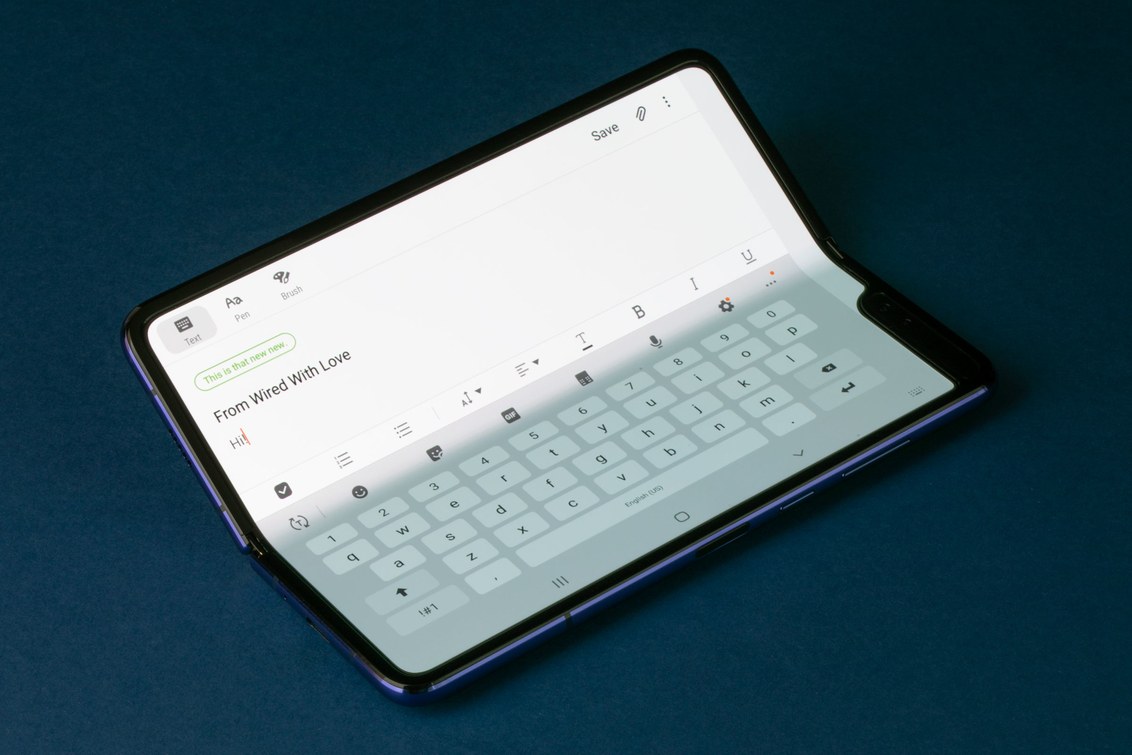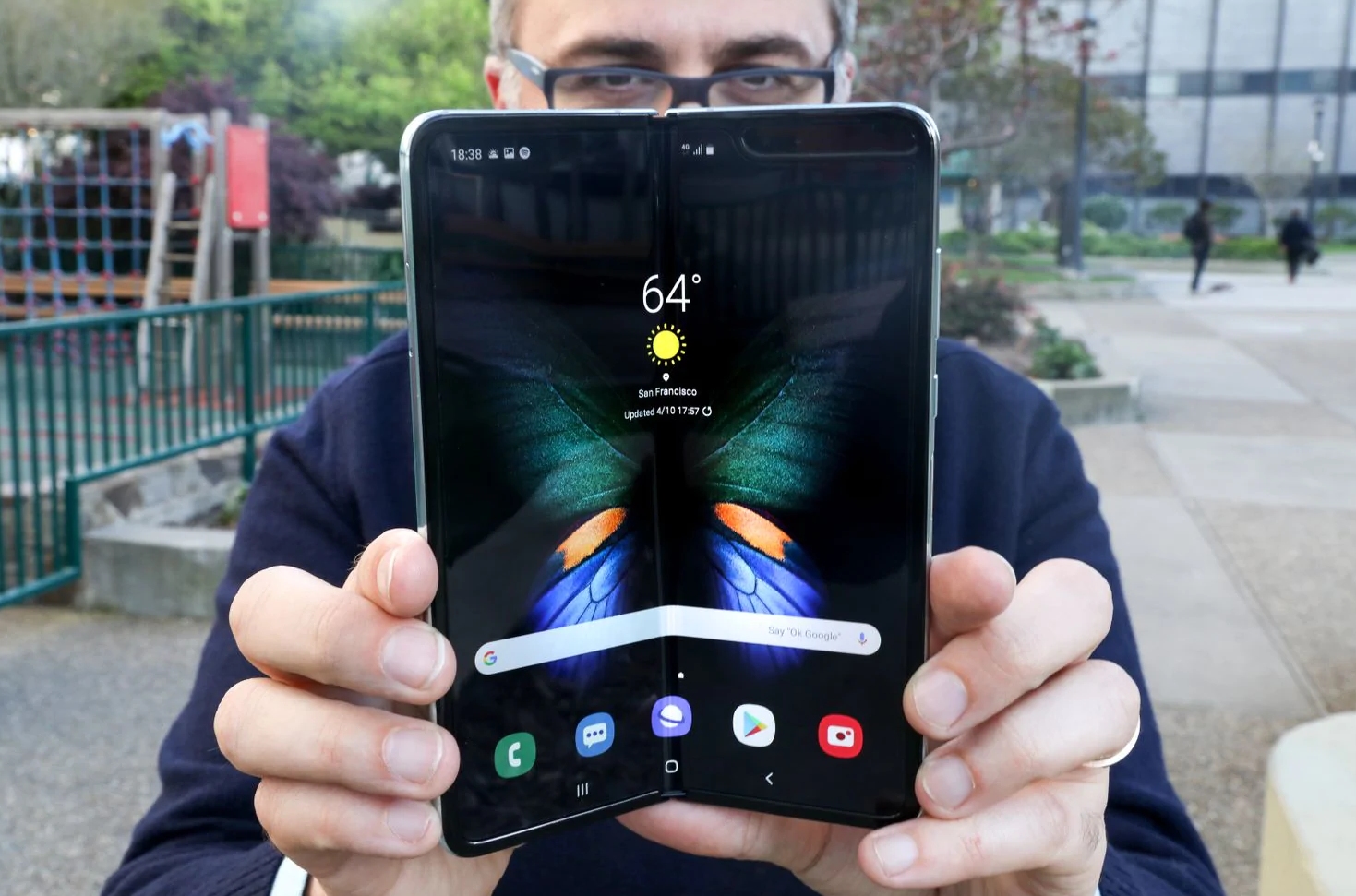In brief: The general consensus following a brief hands-on period is that the Galaxy Fold feels like more of a polished product and less of a concept or first-gen device than you'd expect. It's far from perfect, however, as there is a crease that you can both feel and see at extreme angles, the front (outer) screen is comically small, the notch on the inside is large and the near $2,000 price tag is tough to swallow. Still, overall sentiment is positive and that's good news for Samsung and the foldable category as a whole.
Samsung's first foldable smartphone, the aptly named Galaxy Fold, launches on April 26 following months of teasing and hype. Up to this point, virtually everything we've seen and heard about the Fold has been dictated by Samsung as nobody outside the company's walls has had an opportunity to play with the device (or been authorized to speak on it publicly).
That all changed this weekend, however, as Samsung invited select journalists to a hands-on session with the Fold. Here's what they're saying following the embargo lift earlier this morning.
The Verge's Dieter Bohn cut right to the chase with a TL;DR summary:
Here's the TL;DR most of you are waiting for: it feels much more stable and polished than I expected going in, but there is still some work to be done on the software. Okay, here's what you are really waiting for: you can see (and feel) the crease on the folding screen, but it's really not that noticeable and perhaps worth the trade-off of having a big screen that you can fold up.
Lauren Goode from Wired gets a feel for the folded Fold:
When it's closed, the Galaxy Fold looks like two elongated phones pressed together, attached by a hinge on one side. It's made of aluminum, and the front and back of the phone---how to best describe a phone that is a single phone but has separate physical elements---are constructed of Gorilla Glass. I managed to squeeze the folded-up Fold into the side pocket of one of my most fitted jackets, but it's inelegant in this state. You can hold it in one hand, sure, but it feels like carrying a TV remote.
The display on the face of the phone has a 4.6-inch diagonal, and occupies a relatively small portion of the available space. During the brief time I used it, I tapped the bottom of the phone many times when it was closed, expecting a virtual home button to be there. But it's much higher up on the face of the phone, because of where the touchscreen display starts. There is a learning curve with the Fold.
Fast Company's technology editor, Harry McCracken, shares his thoughts on what it's like to open and close the Fold:
You open the Fold like a book, pulling back its top half from the right edge until the device is a slab rather than a screen sandwich. As you unfold, the hinge, with a diamond-cut Samsung logo designed to create prismatic effects as it reflects light, disappears behind the two halves of phone, which is a pretty nifty trick in itself. Samsung has engineered the mechanism within---which actually consists of two hinges with interlocking gears---to survive 200,000 openings and closings without flinching: "You can fold and unfold it a hundred times a day for five years, guaranteed," says Koh.
The whole opening-and-closing maneuver feels solid and satisfying, like slamming the door on a luxury car. As I unfolded the phone, however, I was prone to accidentally pressed the fingerprint scanner, which doubles as a Bixby button---thereby summoning Samsung's not-so-great voice assistant. With time, I'd presumably learn to pry the Fold open without any unintended consequences.

TechRadar's John McCann on the unfolded Fold:
The larger, tablet display features an advanced composite polymer layer, which is stuck to the body with a foldable adhesive, allowing the display to bend, flex and stay on the device. It's also the thinnest display Samsung has ever made.
When folded out, you're greeted by a 7.3-inch, QHD+ Super AMOLED display with is bright, clear and crisp with plenty of color fired directly into your eyes. It also supports HDR10+, providing an enhanced viewing experience with supported video.
However, there is one fairly major point to note about this display. The crease.
Looking at the display at an angle, and there's a noticeable crease running down the entire length of the screen in the middle, where it folds. It's not something that came be remedied, and you'll have to accept the fact it's there if you do opt to splash the cash on the Galaxy Fold.
Eli Blumenthal and Edward C. Baig from USA Today go beyond the folding aspect in their analysis:
There is no headphone jack, though Samsung does include a pair of its wireless $129 Galaxy Buds in the box.
While there is a 5G model in the works for the U.S. market (and one will be sold overseas) the version of the Fold launching next week in the States will only work on AT&T and T-Mobile's 4G LTE networks. There is also no unlocked model in the U.S. for use on Verizon or Sprint.
Unlike other recent Galaxy phones, the Fold is not water resistant either. Living on the edge requires you to make some sacrifices.

Jessica Dolcourt with CNET dishes on cost:
Foldable phones will start off ultra expensive – the 4G version of the Fold starts at $1,980 and the Mate X costs about $2,600 – and there may be kinks to work out. (UK and Australian prices are TBA, but $1,980 converts to about £1,500 or AU$2,750.) But if enough people clamor for a device that puts a big screen in a little body, then a foldable phone design has the chance to change the way people use their phones: multitasking, interacting with the device and possibly even making other devices, like a tablet, obsolete. I've said it before: foldable phones are the wild west.
Max Parker from Trusted Reviews isn't quite as sold on the Fold as some of his colleagues:
The hype surrounding the Fold felt like it dipped as soon as Huawei launched the equally foldable Mate X. The Mate X's single screen folds outwards, as opposed to two external and internal screens on the Fold, and the whole way it fits together feels so much more complete than the Fold as a result. I could see myself jumping straight into using the Mate X, while I think they'll be some major adjustments needed to help with the Fold feel familiar.
Geoffrey A. Fowler with The Washington Post is reserving final judgment until he can integrate the device into his daily routine:
It's going to take more time to understand whether the Fold is the future or just a Frankenphone. A smartphone and tablet in one could be convenient ... or do both jobs less well. I suspect it has more potential as a replacement for a tablet than as a phone. To find out, I would need to operate the Fold one-handed on my morning commute, try to burn through emails at a coffee shop, and catch up on my Netflix queue on a flight.
Lead image courtesy Jhaan Elker, The Washington Post
